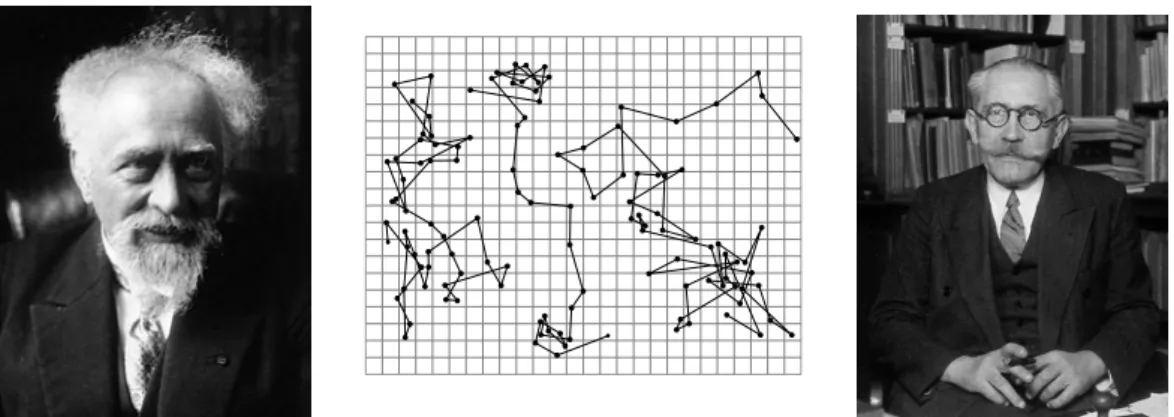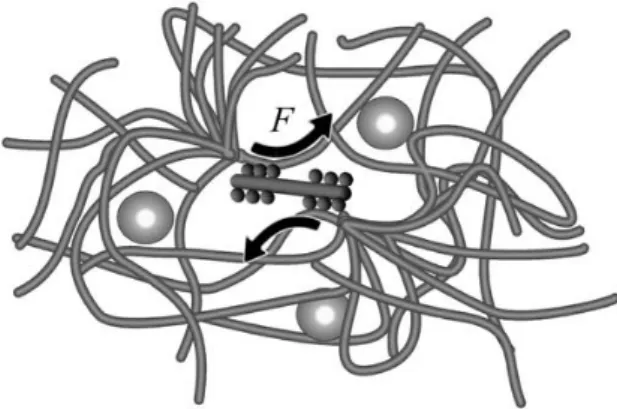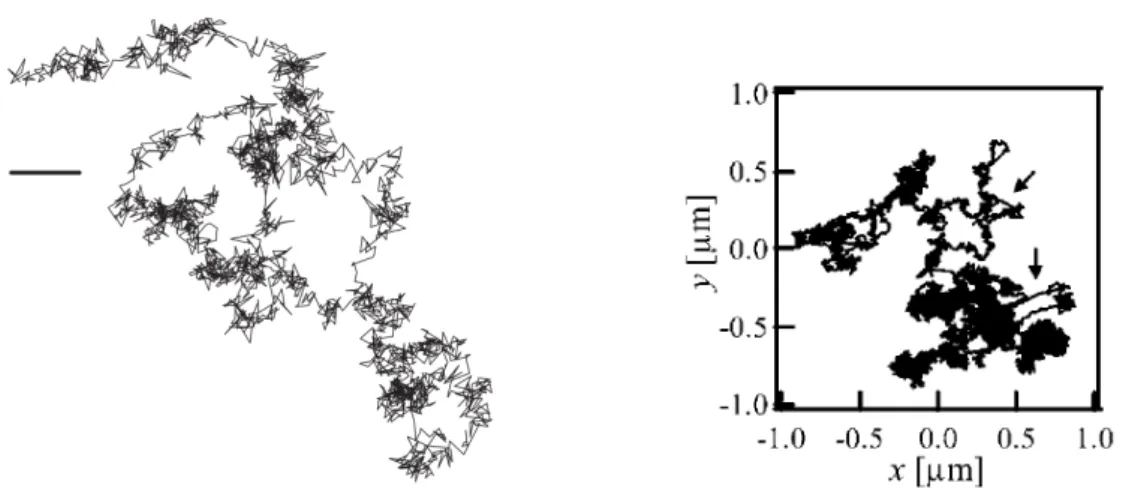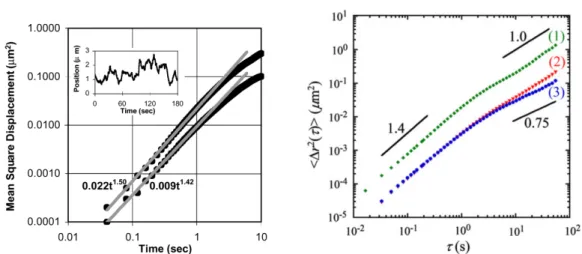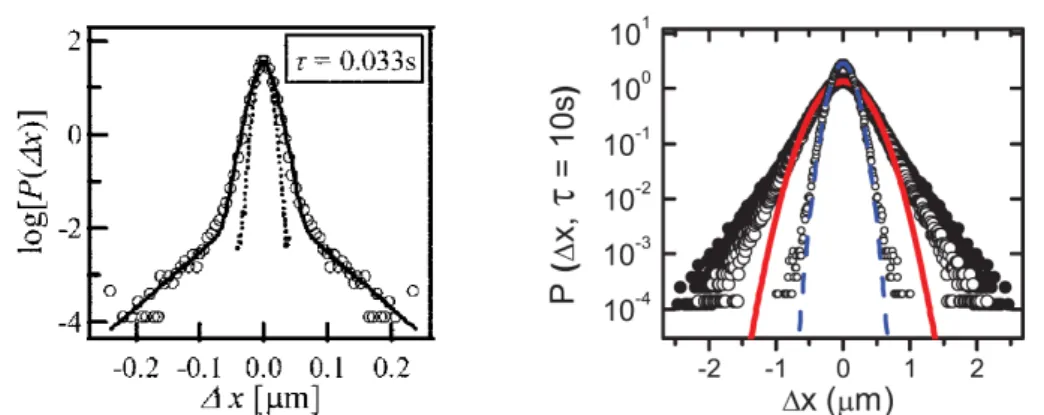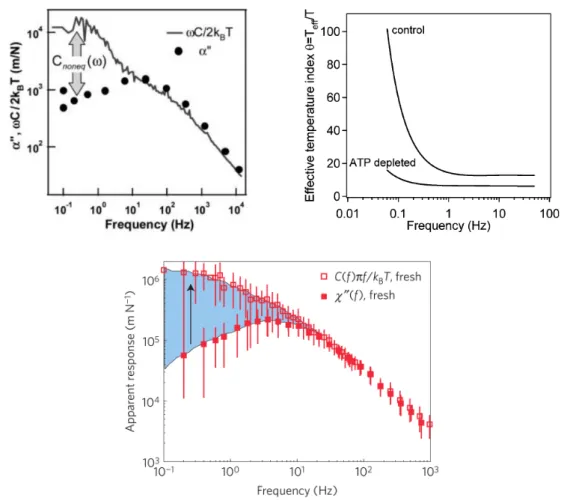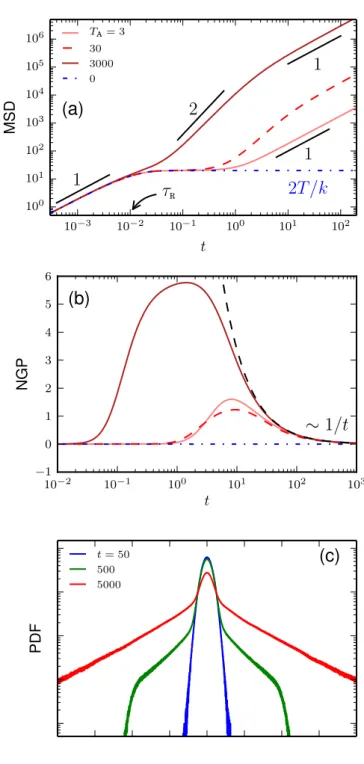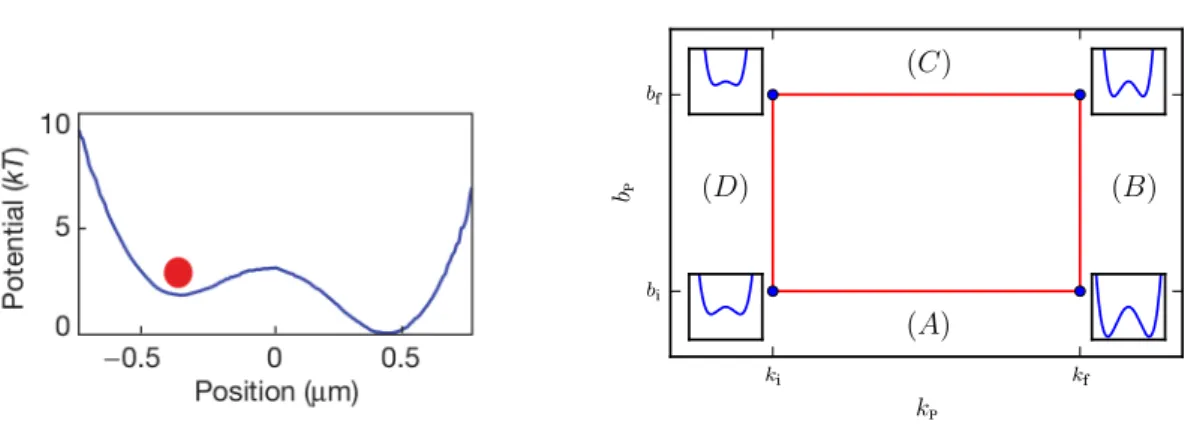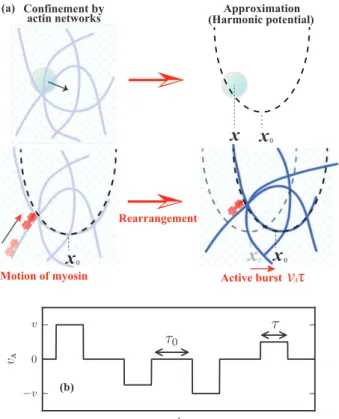HAL Id: tel-01345451
https://tel.archives-ouvertes.fr/tel-01345451v2
Submitted on 4 Nov 2016
HAL is a multi-disciplinary open access
archive for the deposit and dissemination of
sci-entific research documents, whether they are
pub-lished or not. The documents may come from
teaching and research institutions in France or
abroad, or from public or private research centers.
L’archive ouverte pluridisciplinaire HAL, est
destinée au dépôt et à la diffusion de documents
scientifiques de niveau recherche, publiés ou non,
émanant des établissements d’enseignement et de
recherche français ou étrangers, des laboratoires
publics ou privés.
To cite this version:
Etienne Fodor. Tracking nonequilibrium in living matter and self-propelled systems. Physics [physics].
Université Paris Diderot, 2016. English. �tel-01345451v2�
École Doctorale “Physique en Île-de-France”
Thèse de doctorat
Discipline : Physique théorique
présentée par
Étienne Fodor
Signatures hors de l’équilibre
dans les systèmes vivants et actifs
Tracking nonequilibrium in living matter
and self-propelled systems
dirigée par Paolo Visco et Frédéric van Wijland
Soutenue le 4 juillet 2016 devant le jury composé de
Eric Bertin
examinateur
Chase P. Broedersz
rapporteur
David S. Dean
rapporteur
Jean-François Joanny
président
Paolo Visco
co-directeur de thèse
I would like to warmly thank my Ph.D. advisors, Paolo Visco and Frédéric van
Wijland, for their support, guidance and encouragement all along the three years
of my Ph.D. thesis. I have highly benefited from all the enthusiasm, clarity and
rigor that characterize their supervision. I am indebted to Nir S. Gov for the
recurrent discussions which have largely contributed to shape my conception of
active fluctuations in living matter. I am very grateful to Julien Tailleur for sharing
his vision of active matter which has motivated the second part of my thesis, and
I sincerely thank Julien for his overall support. I am also thankful to Cesare
Nardini and Michael E. Cates for their collaboration in the study of self-propelled
particles as an active matter system. Besides, I would like to thank the members
of my thesis committee: Eric Bertin, Chase P. Broedersz, David S. Dean and
Jean-François Joanny, for accepting to evaluate my Ph.D. work. In particular,
I am grateful to the referees, Chase P. Broedersz and David S. Dean, for their
comments which enabled me to improve this manuscript.
Moreover, I would like to express my sincere gratitude to the three different
experimental groups with whom I had the opportunity to collaborate. I am grateful
to David A. Weitz and Ming Guo for sharing their results on tracer dynamics
inside living melanoma cells, as a first insight into the captivating issues raised
by the intracellular dynamics. I thank Timo Betz and Wylie W. Ahmed for the
fruitful collaboration that we had all along my Ph.D. thesis. I really enjoyed
our collaborative effort to analyze the dynamics within living mouse oocytes as a
fascinating nonequilibrium material. I am thankful to Marie-Hélène Verlhac and
Maria Almonacid who provided us with the oocytes. My sincere thanks also go
to Daniel Riveline, Vishu Mehandia, Jordi Comelles and Raghavan Thiagarajan.
Our collaboration has been a stunning opportunity to complement our study of
active fluctuations in living matter with epithelial tissues.
Furthermore, I am obliged to Hisao Hayakawa for providing me with the
oppor-tunity to visit the Yukawa Institute of Theoretical Physics at Kyoto University.
non-Gaussian fluctuations. I thank the Ph.D. students of the Advanced
Statis-tical Mechanics group for the many interesting discussions that we had, notably
Kiyoshi Kanazawa and Tomohiko Sano.
Besides, I am very grateful to
Shin-ichi Sasa, Takahiro Nemoto and Andreas Dechant for sharing their insight into
nonequilibrium statistical mechanics.
Eventually, I would like to thank the various members of the laboratory Matière
et Systèmes Complexes for the very nice working atmosphere in which I enjoyed
studying during the past three years. In particular, I am grateful to François
Graner, François Gallet, Atef Asnacios, Sylive Hénon, Fabien Montel, Jean-François
Berret and Jean-Baptiste Fournier for insightful discussions. Besides, I also thank
the many Ph.D. students who made the everyday life in the laboratory so
ani-mated: Thomas, Gwen, Tanguy, Simon, Mourtaza, Agnese, Alex, Sham, David,
François, Iris and others.
Introduction
1
1
Modeling the fluctuations of passive tracers
7
1.1
Tracer in a thermal bath
. . . .
8
1.2
Nonequilibrium dynamics driven by active fluctuations
. . . .
12
2
Living matter: a paradigm of nonequilibrium systems
17
2.1
Structure and dynamics of the intracellular environment
. . . .
18
2.2
Measuring fluctuations and response
. . . .
20
2.2.1
Statistics of tracer displacement
. . . .
21
2.2.2
Mechanical properties at the subcellular scale
. . . .
24
2.3
Models for the intracellular mechanics and dynamics
. . . .
27
3
Active cage model of fluctuations in living cells
31
3.1
Caging dynamics
. . . .
32
3.2
Model predictions
. . . .
36
3.2.1
Statistics of tracer displacement
. . . .
36
3.2.2
Energetics of active fluctuations
. . . .
39
Paper A: Energetics of active fluctuations in living cells
. . . .
43
4
Colloidal tracers in living melanoma cells
55
Paper B: Activity-driven fluctuations in living cells
. . . .
59
5
Vesicle dynamics in living mouse oocytes
67
Paper C: Active mechanics reveal molecular-scale force kinetics in living
oocyte
. . . .
75
7
Nonequilibrium properties of persistent self-propelled particles
137
7.1
Self-propelled particles as an active matter system
. . . 138
7.2
Interacting particles under persistent fluctuations
. . . 140
7.3
Effective equilibrium regime
. . . 146
Paper F: How far from equilibrium is active matter?
. . . 149
7.4
Collective modes
. . . 156
Main results and outlook
163
A Persistent self-propelled particles: approximate dynamics
167
B Persistent self-propelled particles: Dean-Kawasaki equation
173
Paper G: Generalized Langevin equation with hydrodynamic
back-flow: Equilibrium properties
177
Paper H: Active cell mechanics: Measurement and theory
183
Paper I: Modeling the dynamics of a tracer particle in an elastic
active gel
195
Paper J: Active cage model of glassy dynamics
204
Bibliography
212
The aim of statistical mechanics is to describe the properties of macroscopic
sys-tems from the sole knowledge of their microscopic constituents and of their
inter-actions. The predictions of statistical mechanics offer the opportunity to compare
a wide range of systems by using a reduced number of macroscopic quantities.
Equilibrium systems are characterized by very specific properties both at the
dy-namical and stationary levels. An important feature of equilibrium systems is the
time reversibility of their dynamics. It constrains the relaxation after a (small)
perturbation to be fully encoded in the spontaneous stationary fluctuations.
More-over, fluctuations in equilibrium are entirely controlled by only two parameters: the
temperature and the friction coefficient with the surrounding thermostat, which
endow these fluctuations with a strong sense of universality. No further details
from the thermostat are at play.
Waiving the constraints of equilibrium opens the door to a wide variety of
nonequilibrium dynamics. The first nonequilibium systems that come to mind are
systems caught during their relaxation towards equilibrium. Others can be
main-tained out-of-equilibrium by applying an external field enforcing a steady flux, such
as a particle or charge current, or an energy flux. Yet another class of
nonequi-librium systems comprises systems in which energy is injected and dissipated at
the microscopic level of their individual components [
1
]. These are called active
systems, and they are the main focus of the present study. The energy stored in
the environment, most often in a chemical form, is converted into mechanical work
to produce directed forces and thus directed motion.
By contrast to equilibrium settings, the breakdown of equilibrium laws in
ac-tive systems can be used to extract quantitaac-tive information about the microscopic
active processes making up the energy reservoir. One can access the kinetic
de-tails of the fluctuations, to be characterized in terms of time, length and energy
scales. In equilibrium, the reversibility of the dynamics is enforced by the detailed
balance principle: the forward and reverse transitions between microstates are
equally probable in a steady state. The existence of an arrow of time only emerges
systems because of the irreversibility of the dynamics. Recent methods of
stochas-tic thermodynamics have been proposed to extend thermodynamic concepts when
fluctuations are of paramount importance [
3
]. They provide a powerful framework
to relate the breakdown of time reversal to the microscopic energy conversion at
the basis of the nonequilibrium dynamics. We will discuss some of the most fruitful
ideas of this developping field in Chapter
1
.
From individual tracers in living systems ...
A paradigm of active systems are living systems. In living cells, it is the
contin-uous injection of energy provided by adenosine triphosphate (ATP) which initially
triggers the activity of intracelullar nonequilibrium processes. For instance, the
molecular motors can convert the chemical energy provided by ATP hydrolysis
into a mechanical work to exert forces within the cell. The ensuing fluctuations
are referred to as active fluctuations, distinct from the thermal fluctuations already
present in the absence of nonequilibrium activity. The effect of these fluctuations
is apparent in a large variety of living systems, from individual crawling cells to
cell aggregates and epithelial tissues. They drive the dynamics of intracellular
components, such as proteins, organelles and cytoskeletal filaments [
4
,
5
]. Tracer
particles are injected in living cells to probe these fluctuations. Alternatively,
the intracellular environment is reconstituted in vitro as minimal model systems.
Recent progress in tracking methods allow one to gather a large amount of
statis-tics to analyze the tracer displacement. Moreover, the tracer can be manipulated
to measure the response of the system: it reveals the viscoelastic properties of
the intracellular medium [
6
–
8
]. These techniques, known as microrheology, are
presented in our overview in Chapter
2
. Combining measurements of the
sponta-neous fluctuations and of the response, the departure from equilibrium is generally
quantified by a frequency dependent effective temperature [
9
]. Yet, its physical
interpretation is at best limited. Not only does it lack any microscopic
interpre-tation, unlike the kinetic energy of thermal agiinterpre-tation, but it also depends on the
measured observables.
To go beyond this characterization of the intracellular nonequilibrium
proper-ties, one has to rely on a modeling of the tracer dynamics. Based on experimental
observations, we propose a phenomenological picture for the constant remodeling
of the intracellular environment in terms of an active cage subjected to random
hops. Our minimal model, which we present in Chapter
3
, reproduces qualitatively
and quantitatively the fluctuations and the departure from equilibrium reported
experimentally. It provides a useful framework to analyze fluctuations and
re-sponse in actual living systems, allowing one to extract information about the
intracellular activity. These applied quantitative aspects come in the subsequent
Chapters
4
,
5
and
6
.
To test our predictions with experimental data, we consider three different
liv-ing systems. First, we treat the dynamics of tracers injected in livliv-ing melanoma
cells under three conditions: motor inhibited cells, ATP depleted cells, and
un-treated cells as a control. We demonstrate that our predictions are consistent with
a series of measurements, supporting the validity of our phenomenological picture.
We provide a quantitative characterization of active fluctuations in terms of time,
length and energy scales (Chapter
4
). Second, we propose a detailed analysis of
fluctuations in living oocytes as probed by intracellular vesicles. We estimate the
energy fluxes between the active processes, the tracer and the thermostat. In
par-ticular, we reveal that the efficiency of energy transduction from the cytoskeleton
remodeling to the tracer motion is very low (Chapter
5
). Eventually, we investigate
the dynamics of epithelial tissues through the fluctuations of tricellular junctions,
named as vertices. The analysis of vertex fluctuations provides a synthetic
read-out of the effect of inhibitors acting on the molecular pathway regulating motor
activity (Chapter
6
).
... to interacting self-propelled particles
Another canonical example of active systems are the ones made of
interact-ing self-propelled constituents. The first experimental studies of such systems
were concerned with biological systems in which the emerging phenomenology
results from various complex ingredients. As an example, the interplay of the
self-propulsion, of the alignment interaction, and of the hydrodynamics
interac-tion drive the dynamics in dense swarms of bacteria [
10
].
To create minimal
biomimetic systems, motile colloids with well-controlled properties have been
syn-thesized in the past decades. As an example, Janus particles have two different
sides with distinct physical and/or chemical properties [
11
]. Such a symmetry
breaking induces a local gradient in the surrounding environment, of either
ther-mal, electric or chemical origin, which results in a self-propelled motion. Inspired
by such experimental systems, recent theoretical works have focused on simple
models of interacting active particles. These have shed light on the mechanism of
the transition to collective motion in the presence of aligning interactions [
12
], and
shown the possibility of a motility-induced phase separation (MIPS) even when
the pair interaction between particles is purely repulsive [
13
,
14
].
Despite the nonequilibrium nature of active particles, it is often difficult to
precisely pinpoint the truly nonequilibrium signature in their emerging properties.
For instance, MIPS is not associated with the emergence of steady-state mass
cur-rents. Even for systems with steady currents, the connection to equilibrium physics
can sometime be maintained – the transition to collective motion amounts in some
matter. Building a thermodynamic approach for active matter first requires
under-standing how active systems depart from equilibrium. We investigate in Chapter
7
the nonequilibrium properties of a specific dynamics for which the self-propulsion
is embodied by a persistent noise. We report on existing approximated treatments
of such dynamics, and we determine the steady state distribution within a
system-atic approximation scheme. It allows us to quantify the time reversal breakdown
of the dynamics and to delineate a bona fide effective equilibrium regime.
Outline
• Chapter
1
– Review of nonequilibrium statistical mechanics: Langevin
equa-tion, fluctuation-dissipation relaequa-tion, entropy producequa-tion, Harada-Sasa
rela-tion, stochastic thermodynamics.
• Chapter
2
– Review of the biological framework: mechanics and dynamics
at the subcellular scale, microrheology techniques, previous modeling of the
intracellular environment.
• Chapter
3
– Minimal model of tracer dynamics in living cells:
phenomenolog-ical motivations, analytic and numerphenomenolog-ical predictions for the tracer statistics,
departure from equilibrium, energetics of nonequilibrium fluctuations
(pa-per
A
).
• Chapter
4
– Insight into the dynamics within living melanoma cells:
anal-ysis of tracer fluctuations, extracting an active temperature three orders of
magnitude smaller than the bath temperature, quantifying the amplitude of
active forces and their time scales (paper
B
).
• Chapter
5
– Analyzing fluctuations inside living mouse oocytes: including
memory effects in the modeling, extracting force and time scales in line with
estimations from single motor experiments, quantifying dissipation of energy,
estimating the very low efficiency of power transmission from the intracellular
network rearrangement to the tracer dynamics (papers
C
and
D
).
• Chapter
6
– Understanding the regulation of fluctuations in epithelial tissues
by molecular motors: extracting active parameters from the statistics of
ver-tex fluctuations (energy, time, and length scales), establishing a correlation
between the hierarchy in the molecular pathway controlling motor activity
and the mesoscopic fluctuations of the tissue (paper
E
).
• Chapter
7
– Collective dynamics of interacting self-propelled particles:
re-view of the phenomenology and existing approximate treatments of the
dynamics, derivation of the steady state based on a systematic
perturba-tion scheme, existence of an effective equilibrium regime and the
associ-ated fluctuation-dissipation relation, hydrodynamic equations and collective
modes (paper
F
).
Modeling the fluctuations of
passive tracers
In this introductory Chapter, we first present the modeling of the dynamics of
a passive particle subjected to equilibrium fluctuations. We introduce the
phe-nomenological description proposed by Paul Langevin after the seminal
experi-ment by Jean Perrin. We highlight the importance of the fluctuation-dissipation
theorem (FDT), as well as its practical consequences for the characterization of a
thermal bath. Second, we discuss the case of a nonequilibrium dynamics driven by
active fluctuations. We report on methods used to extract qualitative and
quan-titative information from the violation of the FDT, with a view to analyzing the
nonequilibrium source of the dynamics.
The seminal experiment performed by the Jean Perrin in the early twentieth
cen-tury was one of the first attempts to extract quantitative information from the
dynamics of tracers immersed in a thermal bath [
17
]. Thanks to the development
of optical tools, he could resolve the trajectories of colloidal grains suspended in
water with unprecedented accuracy, yielding the picture reported in Fig.
1.1
. In
his observations, Perrin noticed that the trajectories were so erratic that one could
not quantify properly the velocity of the grains. The discontinuity in the trajectory
between two successive measurements led to wrong estimates. Both the direction
and the norm of velocities did not converge to any limit as the accuracy of
mea-surement was increased. Indeed, the individual collisions between the colloidal
grains and the solvent molecules were by far beyond experimental resolution, so
that the variations of velocity observed by Perrin already resulted from a large
number of such collisions.
Langevin dynamics
These experiments motivated the theoretical description developed by Paul
Langevin at the same period [
18
]. In his approach, Langevin deliberately avoids
a kinetic description of the collisions between the tracer particle and the bath
particles. He postulated that the effect of these collisions could be rationalized by
two forces. A viscous friction force −γv opposed to the displacement of the tracer,
where v and γ respectively denote the tracer velocity and the friction coefficient,
and a stochastic force ξ. According to the second Newton law, the dynamics
follows as
m ˙v = −∇U − γv + ξ,
(1.1)
where m is the particle’s mass, and −∇U is the force deriving from an arbitrary
potential U . When inertial effects can be neglected, the dynamics is simplified as
γ ˙r = −∇U + ξ.
(1.2)
This is the Langevin dynamics in its overdamped formulation. Stokes law states
that the friction coefficient reads γ = 6πηa for spherical tracers of radius a, where
η denotes the fluid’s viscosity. The stochastic force ξ is a Gaussian white noise
with correlations hξ
α(t)ξ
β(0)i = 2γT δ
αβδ(t), where T is the temperature of the
surrounding bath, and the Greek indices refer to the spatial components.
Based on this phenomenological approach, one can predict the time evolution
of a number of observables. Perhaps the most intuitive observable to consider
is the mean-square displacement (MSD) defined as h∆r
2(t, s)i = h[r(t) − r(s)]
2i,
which only depends on the time difference t − s at large times. From the
dynam-ics (
1.1
), one can deduce that, for a free particle, the MSD behaves at large times
Figure 1.1 – Pictures of Jean Perrin (left), and Paul Langevin (right).
Middle: Three trajectories of colloidal particles of radius 0.53 µm where
measurements are taken every 30 s. Reproduced from the book Les Atomes
of Jean Perrin. Mesh size 3.2 µm.
as h∆r
2(t)i ∼ 2dDt, where we have introduced the diffusion coefficient D = T /γ,
and d refers to the space dimension. Another observable of interest is the
autocor-relation function of velocity hv(t) · v(s)i. It only depends on the time difference
t − s at large times, and it is related to the diffusion coefficient as
D =
1
d
Z ∞
0
hv(t) · v(0)i dt.
(1.3)
This definition connects the amplitude of the thermal fluctuations to the
relax-ation of the velocity, which is driven by the dissiprelax-ation of energy from the tracer
to the thermostat.
Fokker-Planck equation
Beyond the relaxation of the dynamics, some specific features of equilibrium
can also be found in the stationary properties of the tracer. These properties
are encoded in the steady state distribution of velocity and position. To obtain
such a distribution from the underdamped dynamics (
1.1
), we first express the
time evolution for the probability P (v, r, t) of finding the tracer at position r with
velocity v at time t. It is given by the following Fokker-Planck equation [
19
]:
∂P
∂t
= −v
α∂P
∂r
α+
1
m
∂U
∂r
α∂P
∂v
α+
γ
m
∂
∂v
α "v
α+
T
m
∂
∂v
α !P
#,
(1.4)
where we have used the convention of summation over repeated indices, as for the
following Chapters. The stationary distribution, known as the Maxwell-Boltzmann
PS
(v, r) ∼ exp
−
U (r)
T
−
mv
22T
.
(1.5)
It can be split into a potential and a kinetic part as a property of equilibrium.
In particular, we deduce that hv
2i = dT /m, which is known as the equipartition
theorem for the velocities. Integrating over the velocities yields the Boltzmann
dis-tribution P
S(r) ∼ e
−U (r)/T
. Alternatively, the Fokker-Planck equation associated
with the overdamped dynamics (
1.2
) reads
∂P
∂t
=
1
γ
∂
∂r
α "∂U
∂r
α+ T
∂
∂r
α !P
#.
(1.6)
The stationary distribution directly follows, and coincides with the Boltzmann
distribution, as it should.
Fluctuation-dissipation theorem
To probe the equilibrium properties of the dynamics, an external operator can
perturb the dynamics and measure the relaxation of the system. We consider that
the underdamped dynamics (
1.1
) is perturbed by applying a force f(t) of small
amplitude to the tracer:
m ˙v = −∇U + f − γv + ξ.
(1.7)
The response function R quantifies how the average position is affected by the
perturbation:
R
αβ(t, s) =
δ hr
α(t)i
δf
β(s)
f =0.
(1.8)
Causality enforces that it vanishes when t
6 s, and it only depends on the time
difference t − s provided that the dynamics has reached a steady state. For an
equilibrium dynamics, the response function can be related to correlations in the
absence of the perturbation Cαβ
(t) = hrα(t)rβ(0)i as
R
αβ(t) = −
1
T
dC
αβdt
.
(1.9)
This is the dynamic version of the FDT. It formally expresses the fact that the
thermal fluctuations and the damping force originate from the same microscopic
process, namely the collision between the tracer and the bath particles.
Introduc-ing the Fourier transform of an arbitrary function
F (t) as F (ω) =
RF
(ω) + i
F
(ω), where
F
(ω) and
F
(ω) denote its real and imaginary parts,
respectively, the FDT can be expressed in the Fourier domain as
T =
ωC
αβ(ω)
2R
00αβ
(ω)
.
(1.10)
A major consequence of the FDT is that one can independently measure the
re-sponse function and the position autocorrelation, by perturbing the dynamics and
tracking the spontaneous fluctuations of the tracer, respectively, to evaluate the
temperature of an equilibrium bath. Such a method can be extended to an
arbi-trary perturbation defined by U → U − h(t)B(r, v), where h is the strength of the
perturbation. Introducing the generalized response for an arbitrary observable A
as
RG
(t) =
δ hA(t)i
δh(0)
h=0,
(1.11)
the FDT states that [
20
]
RG
(t) = −
1
T
d
dt
hA(t)B(0)i .
(1.12)
It is an important property of equilibrium that the only information that one can
extract from the comparison between response and correlations is the bath
tem-perature.
Generalized dynamics: memory effects
When considering short enough time scales to probe the collisions at the origin
of the thermal forces [
21
], the details of the interactions between the tracer and
the bath affect the Langevin dynamics. When integrating out these interactions,
some memory effect appear in the dynamics [
22
]. Such effects are accounted for
by including a memory kernel γ in the damping force:
m ˙v = −∇U −
Z t
0
γ(t − s)v(s)ds + ξ.
(1.13)
The correlations of the stochastic force are also modified as
hξ
α(t)ξ
β(0)i = T δ
αβγ (|t|) .
(1.14)
The FDT (
1.12
) is still valid, as a property of an equilibrium bath. The relation
between the damping kernel and the noise correlations is a direct consequence of
the FDT [
23
]. Some hydrodynamic effects may also yield a memory kernel [
24
].
Moreover, memory effect can arise when considering a complex bath beyond the
simple case of water, such as a gel of polymers [
25
,
26
]. As an example, power-law
of the tracers, either superdiffusive or subdiffusive behavior depending on the
properties of the kernel.
1.2
Nonequilibrium dynamics driven by active
fluctuations
We now consider the dynamics of a tracer subjected to thermal and active
fluctua-tions. We take the equilibrium Langevin dynamics in its overdamped formulation
as a passive reference:
γ ˙r = −∇U + ξ + fA,
(1.15)
where we have introduced the active force f
A. We want to investigate the effect
of this force on the dynamics of the tracer. To this aim, we report on methods
used to reveal the nonequilibrium properties of the dynamics from the violation of
equilibrium laws, and to relate such violations to the microscopic features of the
active force.
Effective temperature and extended fluctuation-dissipation relation
Though one can always define correlations and response in the presence of
an active force, there is no reason for the specific relation given by the FDT to
hold anymore. As a consequence, any method based on comparing response and
correlations at every time scale to measure the bath temperature is no longer valid.
Then, one can wonder if such a method can be extended far from equilibrium
to assess asymptotic regimes where temperatures can be defined. These may a
priori differ from the bath temperature, and are to be related to the energy scales
involved in the active force. An early attempt to get an insight these issues has
been to define a frequency-dependent effective temperature, by analogy with the
FDT (
1.10
), as [
9
]
T
eff(ω) =
ωC
αβ(ω)
2R
αβ00(ω)
.
(1.16)
It reduces to the bath temperature at large frequencies provided that the
colli-sions at the origin of thermal fluctuations occur on time scales shorter than any
of the microscopic processes powering active fluctuations. In that respect, the
typical frequency at which the effective temperature departs from the equilibrium
prediction provides information about the shortest time scale involved in these
fluctuations. Alternatively, the definition of a time-dependent effective
tempera-ture can also provide some insight into the nonequilibrium dynamics. It has been
used in sheared fluids to propose the existence of two distinct temperatures
as-sociated with different time scales [
27
,
28
]. However, the physical interpretation
of the effective temperature is at best limited. It does not contain the universal
meaning of a temperature, since the violation of the FDT is different for each
type of perturbation. Besides, there is no clear connection with any underlying
microscopic processes driving the dynamics far from equilibrium.
Though the FDT is violated out-of-equilibrium, the response can still be related
to additional correlations which involves the potential and the active force [
29
,
30
]:
R
αβ(t) = −
1
2T
dC
αβdt
+
1
2γT
Dr
α(t) (f
A− ∇U )
β(0)
E,
(1.17)
Measuring the temperature from response and correlations now requires the
knowl-edge of the potential and the active force by contrast to equilibrium. Moreover,
the additional correlations of the extended fluctuation-dissipation relation (FDR)
in Eq. (
1.17
) depend on the type of perturbation, thereby breaking the universal
formulation of the FDT in Eq. (
1.12
). From a practical perspective, the FDR
can be used to deduce the correlation between tracer position and non-thermal
forces [
31
,
32
]. The FDR can be cast in the following form:
R
αβ(t) = −
1
T
dC
αβdt
+
1
2γT
hDr
α(t) (f
A− ∇U )
β(0)
E−
Dr
α(0) (f
A− ∇U )
β(t)
Ei.
(1.18)
In the equilibrium case for which the dynamics is invariant under a time reversal,
the second term in Eq. (
1.18
) vanishes at all times, and the FDR reduces to the
FDT as it should. This writing explicitly connects the violation of the FDT with
the time reversal breakdown.
Entropy production
It has been shown in the last decades that the breakdown of time reversibility, as
a hallmark of nonequilibrium, can be quantified by the rate of entropy production.
It is defined in terms of the weights for a given time realization of the forward and
backward processes, provided that the backward one exists, respectively denoted
by P and P
R, as [
33
]
σ = lim
t→∞1
t
ln
P
P
R.
(1.19)
It characterizes the irreversible properties of the dynamics, and it satisfies a
fluc-tuation theorem. Given that the thermal noise term in the dynamics (
7.1
) is
Gaussian, the probability weight can be written as P ∼ e
−A, where the dynamic
action A reads [
34
]
A =
1
4γT
Z t 0(γ ˙r + ∇U − f
A)
2ds.
(1.20)
into Eq. (
1.20
). The entropy production rate follows as
σ =
1
T
t→∞lim
1
t
Z t 0˙r · (f
A− ∇U )ds.
(1.21)
We identify the time and ensemble averages under the ergodic assumption. The
contribution from the potential h ˙r · ∇U i = d hU i /dt vanishes in the steady state,
yielding
σ =
1
T
h˙r · f
Ai .
(1.22)
As a result, the entropy production rate coincides with the power of the active
force divided by the bath temperature. One can use the violation of the FDT to
evaluate the entropy production rate. An important result is that σ can explicitly
be written in terms of such a violation as [
35
,
36
]
σ =
γ
T
lim
t→0d
dt
"T R
αα(t) +
dC
ααdt
#.
(1.23)
It is written in the Fourier domain as
σ =
γ
T
Zdω
2π
ω [ωC
αα(ω) − 2T R
00 αα(ω)] .
(1.24)
This is the Harada-Sasa relation. It provides a simple way to estimate the entropy
production rate by independently measuring response and correlations. In that
respect, it does not require any information about the details of the potential and
the active force. Moreover, it shows that the violation of the FDT can be related to
the microscopic active processes. Considering a generalized overdamped dynamics
with memory effects as
Z t
0
γ(t − s) ˙r(s)ds = −∇U + ξ + fA,
(1.25)
where hξ
α(t)ξ
β(0)i = T δ
αβγ (|t|), the Harada-Sasa relation is extended as [37
]
σ =
1
T
Zdω
2π
ωγ
0(ω) [ωC
αα(ω) − 2T R
00αα(ω)] ,
(1.26)
where γ
0(ω) denotes the real part of the damping kernel in the Fourier domain.
Energy exchanges with the thermostat
A more physical interpretation of the entropy production rate is based on
energy exchanges between the tracer and the surrounding thermostat. According
to the action-reaction principle, the force exerted by the tracer on the heat bath
is opposed to the thermal forces. As a result, the work done by the tracer on the
heat bath per unit time is given by ˙r · (γ ˙r − ξ). This is also the power transferred
from the tracer to the thermostat, as introduced by Sekimoto [
38
,
39
]. These
energetic observables are fluctuating quantities, by contrast to the ones defined in
standard thermodynamics. They are at the basis of stochastic thermodynamics [
3
,
40
], which aims at extending thermodynamic concepts to small systems, for which
fluctuations are of paramount importance.
In equilibrium, the average power transferred to the thermostat is zero. This
is because, on average, the power injected by the thermal fluctuations, which
drives the tracer’s motion, is balanced by the power dissipated through the drag
force. For a nonequilibrium dynamics, there is an extra source of energy due to
the active force. More energy is released into the bath through the drag force
compared with the one injected by the thermal fluctuations only. As a result, the
power transferred to the thermostat is positive. From the expression in Eq. (
1.22
),
it follows that the entropy production rate is simply related to the average power
as σ = h ˙r · (γ ˙r − ξ)i /T . Hence, the entropy production rate is of direct physical
relevance to quantify energy exchanges with the heat bath.
Living matter: a paradigm of
nonequilibrium systems
In this Chapter, we review the biological framework which controls the dynamics
and mechanics in living systems. Then, we present the experimental techniques
used to investigate the fluctuations of the intracellular components as well as the
mechanical properties at the subcellular scale, known as microrheology methods.
We present typical microrheology data, leading us to discuss the complex
rheologi-cal properties of the intracellular environment, and to highlight the nonequilibrium
features apparent in the tracer statistics. For completeness, we present previous
models of the intracellular fluctuations and mechanics.
environment
Cytoskeleton: architecture of the cell
The structure of the cell is supported by a network of polymer filaments named
the cytoskeleton [
41
]. This network is a dynamic entity in constant remodelling.
There are three types of filaments: two of them are polar, namely the actin
ments and the microtubules, and the third ones, known as the intermediate
fila-ments, are apolar. Each kind of filament has different mechanical properties and
is made of different subunits. Thousands of these subunits agglomerate to form
a strand of protein that can extend all along the cell. Intermediate filaments are
fibers with a diameter of approximately 10 nm which are able to deform under a
mechanical stress. The main function of intermediate filaments is to enable the
cells to bear external stress. Microtubules are empty tubes with a diameter of
about 25 nm. They are stiffer than both intermediate and actin filaments, and
they can rupture when stretched. They are crucial in the regulation of the
intra-cellular transport. Actin filaments are helical polymers with a diameter of about
7 nm which are more flexible than the microtubules. They are more abundant in
the cell than both intermediate filaments and microtubules. They can be found
generally in bundles or entangled networks, with connectivity controlled by binding
proteins such as cross-linkers. The assembly and disassembly of actin filaments is
controlled by the hydrolysis of ATP through treadmilling. The properties of actin
networks have received a lot of attention, since they are believed to be the main
filaments controlling the mechanical properties and the motility of the cell.
Molecular motors
Some proteins known as the molecular motors can exert forces on these
fila-ments. These forces result from the conversion of the chemical energy provided
by ATP hydrolysis, which provides around 50 k
BT /mol in normal physiologiccon-ditions, into mechanical work. Each type of motors is associated with specific
filaments. The intermediate filaments being apolar, there is no corresponding
mo-tor. The kinesin and dynein motors are moving along the microtubules in opposite
directions. They carry organelles and vesicles throughout the cell, thereby
regu-lating the intracellular transport at large scales. Similarly, the myosin-I motors
can transport various kinds of cargos along the actin filaments. These motors
can also bind separately to an actin filament and the cell membrane to pull the
membrane into a new shape. Another important type of motors acting on actin
filaments are the myosin-II motors, whose power stroke time is about 10 s. Many
of these motors can bind together to form a myosin filament: a double-headed
Figure 2.1 – Schematic picture of a myosin filament pulling two actin
fila-ment past each other. The resulting modification of the actin network affects
the dynamics of intracellular components, represented in grey circles. Taken
from [
42
].
strand with the two heads pointing in opposite directions. Such filaments can
at-tach to different actin filaments to slide them past each other, as shown in Fig.
2.2
.
The forces produced by these filaments lead to constantly modify the structure of
the actin network. Therefore, motor activity affects the dynamics of intracellular
components not only through directed transport, but also via the remodeling of
the surrounding cytoskeletal network.
Reconstituted in vitro systems
Understanding the mechanical properties of the complex intracellular structure
and predicting the effect of active forces in the cell is largely a challenge to physical
interpretation. As a result, the cytoskeleton is reconstituted in vitro to investigate
its properties in simplified model systems. First experiments have been carried
out in the absence of molecular motors, specifically to study actin filaments [
43
–
45
]: the corresponding network is referred to as a passive gel. These experiments
aimed at characterizing the mechanics and the dynamics of passive gels under
strictly thermal fluctuations. The effect of motor activity was then investigated
by adding myosin filaments in the actin network. Recent studies have studied the
coarsening of the network driven by the motors [
46
,
47
]. In particular, they have
shown that such a collapse into a reduced number of points in the gel can provide
insight into the connectivity of the network, as controlled by cross-linkers [
48
,
49
].
Control parameters
To investigate the role of the different intracellular components in the
mechan-ics and dynammechan-ics within the cell, the system can be subjected to various
treat-Figure 2.2 – Time evolution of acto-myosin networks with different
concen-tration of cross-linkers. From left to right, the molar ratio of cross-linker over
actin concentration varies as 0.01, 0.05, and 0.1. The system collapses into
a reduced number of points as this ratio increases. Scalebar 1 mm. Taken
from [
48
].
ments. For living cells, polyethylene glycol can be added to modify the mechanics
by inducing an osmotic compression [
50
]. The addition of blebbistatin is largely
used to inhibit the activity of myosin-II motors. Besides, the whole cell can also
be depleted in ATP, thus providing an equilibrium-like reference [
51
]. The effects
of the drugs depend on both the cell conditions and the concentration added to
it, and it may affect different components of the cells beyond the targeted one.
Alternatively, mutant cells provide efficient ways to act precisely on specific
com-ponents. Yet, inhibiting one component, such as one type of molecular motors
or cytoskeletal filaments, alters both the mechanics and the dynamics in general,
as discussed below. In contrast, the properties of the reconstituted actin gels are
better controlled, thus providing the opportunity to decipher the role of the
differ-ent constitudiffer-ents of the gels. The concdiffer-entration of motors, filamdiffer-ents, cross-linkers,
and ATP can be varied independently to study the dynamical and mechanical
properties of these model systems.
2.2
Measuring fluctuations and response
Fluctuations and mechanical properties of the intracellular environment are
mea-sured with microrheology techniques [
7
]. They rely on tracking and manipulating
tracer particles, known respectively as passive and active microrheology methods.
These tracers can be either injected in the system [
42
,
51
], or attached to the
cell cortex [
31
,
52
–
54
]. Alternatively, components already present in the system,
such as vesicles in living cells, can also serve as such probes [
51
]. Acto-myosin
gels represent controlled systems for which the motor activity can be regulated
externally through the concentration of ATP. It provides a useful tool to
investi-Figure 2.3 – Typical trajectories of micro-size tracers in living systems.
Left: Beads attached to the cell cortex. Scalebar 10 nm. Taken from [
53
].
Right: Beads injected in an acto-myosin gel. Arrows indicate displacements
of large amplitude. Taken from [
42
].
gate the effect of such an activity in both the fluctuations and the mechanics. In
living cells, the system can also be depleted in ATP, though the properties of the
whole cell get significantly altered by such a treatment. Alternatively, the
activ-ity of some motors can be inhibited via specific drugs, or by considering mutant
cells. Finally, when considering tracers bound to the cell cortex, some tracers are
generally glued to the cortex to provide an equilibrium-like reference sensitive to
thermal fluctuations only.
2.2.1
Statistics of tracer displacement
The trajectories of the tracers probing the dynamics of either the intracellular
environment or reconstituted acto-myosin gels show a similar behavior [
42
,
53
].
Typically, one tracer exhibits locally confined fluctuations, and also experiences
rapid directed motions until it reaches a new position around which it fluctuates
again [Fig.
2.3
]. This suggests that the dynamics are made of intermittent
transi-tions between locally stable positransi-tions.
Mean-square displacement
The statistics of spontaneous displacement is extracted from the particle
track-ing. The time evolution of the MSD provides an intuitive characterization of the
typical excursion of the tracer as a function of time [
8
]. The large time diffusion of
the tracer is controlled by active fluctuations, since thermal diffusion alone is not
efficient enough to regulate the large scale transport across the cell. By contrast
Figure 2.4 – Typical measurements of the mean-square displacement for
tracers injected in living cells showing transient superdiffusive behavior.
Taken from [
55
] and [
57
] in left and right, respectively.
with the dynamics of a tracer immersed in water, it can also exhibit subdiffusive
behavior because of crowding effects in the intracellular environment and
inter-actions with the surrounding cytoskeletal network. Moreover, transient
superdif-fusive behaviors are also assessed and associated with motor activity [
55
–
57
], as
shown in Fig.
2.4
. Overall, a large variety of exponents for the anomalous diffusion
have been assessed. Such a variability has two main origins. First, the different
types of tracers used as probes, either attached to the cortex or injected in the
cell, without various protocols of injection, lead to different interactions with the
intracellular environment. Second, the mechanical properties are modified across
cell types, thus modifying the dynamics even in regimes where thermal
fluctua-tions are predominant. In that respect, a crucial issue is to consider observables
independent of the mechanical properties with a view to analyzing and comparing
fluctuations in different living systems.
Distribution of displacement
Recent improvements in tracking methods also allow one to gather sufficient
statistics to study the time evolution of the whole distribution of displacement.
In a large variety of living systems, ranging from crawling cells to reconstituted
acto-myosin gels [
8
,
42
,
53
,
58
], it typically exhibits a central Gaussian part with
exponential tails [Fig.
2.5
]. As for the MSD, the variance of the central Gaussian
and the extension of the tails are system dependent. In acto-myosin gels, the
com-parison between results of active and passive gels provides an insight into effects of
the motors. The passive distribution is always Gaussian, as expected for an
equi-Figure 2.5 – Typical measurements of the displacement distribution for
tracers injected in acto-myosin gels. It is Gaussian for passive gels, and
exponential tails are present in active gels for which molecular motors are
added. Left: Passive and active gels in dotted lines and open circles,
respec-tively, at same lag time. Taken from [
42
]. Right: Passive and active gels in
small and large symbols, respectively, at same lag time. Taken from [
58
].
librium system. It is reported that the variance of the central Gaussian is enhanced
in the active case compared with its passive counterpart [
58
,
59
]. Therefore, motor
activity also affects the fluctuations of small amplitude. Besides, the mechanical
properties of the surrounding environment controls these fluctuations: motor
ac-tivity also modifies the mechanical properties, as discussed below. The tails get
more pronounced as time increases. Note that the exponential tails are usually
measured within a decade or less, thereby being indistinguishable from power-law
tails. A striking feature of the distribution is the scale invariance reported in
some systems. When scaling the displacement by the variance of either the central
Gaussian part or the whole distribution, which are hardly different provided that
the tails are not so pronounced, both the central part and the tails fall onto a
mas-ter curve [
8
,
53
]. Note that such a scale invariance is also reported in a different
context of tracers immersed in bath made of bacteria [
60
]. This is of particular
interest since it provides the opportunity to compare observables insensitive of the
dynamics, independently of the exponents characterizing the time evolution of the
MSD. In that respect, the deviation from the central scaled Gaussian is perhaps
the simplest feature to be analyzed through different cell types.
parameter is commonly introduced as the scaled kurtosis of the distribution [
61
]:
NGP =
h∆x
4
i
3 h∆x
2i
2− 1,
(2.1)
where ∆x is the one-dimensional projection of the displacement. The NGP
van-ishes when the distribution is Gaussian. It takes positive and negative values when
the distribution is respectively smaller and broader than Gaussian. The main
drawback of measuring the NGP experimentally is that the noise is enhanced with
respect to measurements of the MSD. The NGP reported experimentally usually
exhibits a transient regime of positive values [
8
,
42
,
53
], as shown in Fig.
2.6
. It
corresponds to the time scales at which exponential tails are reported aside the
central Gaussian part of the displacement distribution. At short and large times,
the NGP vanishes, showing that the tracer statistics is asymptotically Gaussian in
these regimes. Note that the NGP shrinks towards negative values at very large
times. This is not due to motor activity, since it is also observed in passive gels
without motors.
2.2.2
Mechanical properties at the subcellular scale
Measurements in living cells
The mechanical properties of the intracellular environment are probed by
mea-suring the response of the tracer to an external perturbation. By contrast to
experiments which investigate the cellular rheology by applying a stress to the
whole cell [
62
], the aim of active microrheology is to characterize the mechanics
at the subcellular scale. Perhaps the main drawback of such methods is the high
variability of the measurements. First, the intracellular environment is a
non-homogeneous medium, so that tracers can experience very different interactions
with the surrounding environment when evolving in various locations in the cell.
Second, the cytoskeleton being a dynamic structure, the local mechanical
prop-erties also vary in time. When comparing response and fluctuations, it is then
crucial to consider active and passive microrheology measurements performed on
the same tracer and with a reduced delay between the two measurements.
The perturbation is commonly applied by means of either optical [
63
,
64
] or
magnetic tweezers [
52
,
65
,
66
]. A simple protocol consists in applying a
step-like force, in which case the response is quantified by the relaxation of the tracer
position. Another type of perturbation relies on applying a time-oscillating force.
As a result, the tracer position oscillates with an amplitude and a phase delay
with respect to the perturbation which are characteristic of the mechanics of the
Figure 2.6 – Typical measurements of the non-Gaussian parameters defined
in Eq. (
2.1
). Up: Beads attached to the cell cortex. Taken from [
53
]. Bottom
left: Beads injected in an acto-myosin gel. Taken from [
42
]. Bottom right:
Beads injected in living cells. Taken from [
8
] .
hδx(t)i =
Z t−∞
